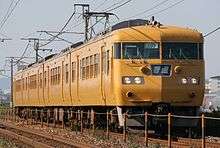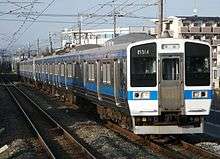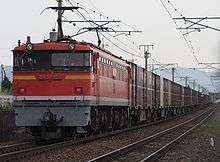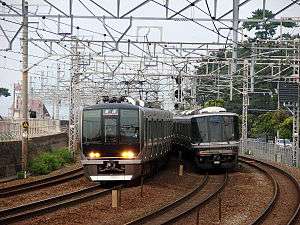San'yō Main Line
| Sanyō Main Line | |
|---|---|
|
321 series and 223-1000 series EMUs on a 4-track section in Kobe | |
| Overview | |
| Native name | 山陽本線 |
| Type | Heavy rail, commuter rail |
| System |
Urban Network (Kōbe - Kamigōri, Hyōgo - Wadamisaki) Hiroshima City Network (Shiraichi - Minami-Iwakuni) |
| Locale | Kansai, Chugoku, Kyushu regions |
| Termini |
Kōbe, Hyōgo Moji, Wadamisaki |
| Stations | 124 |
| Operation | |
| Opened | 1872 |
| Owner |
JR West JR Kyushu |
| Operator(s) |
JR West JR Kyushu JR Freight |
| Technical | |
| Line length |
537.1 km (333.7 mi) 528.1 km (328.1 mi) (Kōbe - Shimonoseki) 6.3 km (3.9 mi) (Shimonoseki - Moji) 2.7 km (1.7 mi) (Hyōgo - Wadamisaki) |
| Track gauge | 1,067 mm (3 ft 6 in) |
| Electrification |
1,500 V DC overhead catenary (Kōbe - Shimonoseki, Hyōgo - Wadamisaki) 20 kV AC 60 Hz overhead catenary (Shimonoseki - Moji) |
| Operating speed |
130 km/h (81 mph) (Kōbe - Okayama) 120 km/h (75 mph) (Okayama - Shimonoseki) 85 km/h (55 mph) (Shimonoseki - Moji, Hyōgo - Wadamisaki) |
The Sanyō Main Line (山陽本線 San'yō-honsen) is major railway line owned by JR Group companies in western Japan, connecting Kobe Station and Moji Station, largely paralleling the coast of the Inland Sea, in other words the southern coast of western Honshu. The Sanyō Shinkansen line largely parallels its route. The name Sanyō derived from the ancient region and highway Sanyōdō, the road on the sunny (south) side of the mountains.
The Sanyō Main Line is operated by the two JR companies West Japan Railway Company (JR West) and Kyushu Railway Company (JR Kyushu). The Wadamisaki Line, a short section of line in length of 2.7 km between Hyōgo and Wadamisaki stations in Kobe is technically part of the Sanyō Main Line. A short section connecting Kitakyushu Freight Terminal also forms part of the Sanyō Main Line.
Basic data
- Operators, distances: 537.1 km / 333.7 mi.
- West Japan Railway Company (Category-1, Services and tracks)
- From Kobe to Shimonoseki: 528.1 km / 328.1 mi.
- From Hyōgo to Wadamisaki: 2.7 km / 1.7 mi.
- Kyushu Railway Company (Category-1, Services and tracks)
- From Shimonoseki to Moji: 6.3 km / 3.9 mi.
- Japan Freight Railway Company (Category-2, Services)
- From Kobe to Kitakyushu Freight Terminal: 534.4 km / 332.1 mi.
- West Japan Railway Company (Category-1, Services and tracks)
- Gauge: 1,067 mm (3 ft 6 in)
- Stations:
- Passenger stations: 124
- Freight terminals: 5
- Track:
- Quadruple-track line:
- From Kobe to Nishi-Akashi: 22.8 km / 14.1 mi.
- From Kaitaichi to Hiroshima: 6.4 km / 4.0 mi.
- Double-track line:
- From Nishi-Akashi to Kaitaichi: 275.5 km / 171.2 mi.
- From Hiroshima to Moji: 208.0 km / 129.2 mi.
- Single-track line:
- From Hyōgo to Wadamisaki
- Quadruple-track line:
- Electric supply: Whole the line (1,500 V DC. Excluding inside Moji Station and Kitakyūshū Freight Terminal, which is 20,000 V AC, 60 Hz.)
- Railway signalling:
- From Kobe to Moji: Automatic
- From Hyōgo to Wadamisaki: Special Automatic (Track Circuit Detection); a simplified automatic system.
- Maximum speed at service:
- From Kobe to Himeji: 130 km/h
- From Himeji to Okayama: Tilting trains 130 km/h, others 120 km/h
- From Okayama to Shimonoseki: 120 km/h
- From Shimonoseki to Moji: 85 km/h
- From Hyōgo to Wadamisaki: 85 km/h
- CTC centers:
- From Kobe to Kamigōri: Shin-Ōsaka Operation Control Center
- From Kamigōri to Itozaki: Okayama Transportation Control Room
- From Itozaki to Shimonoseki: Hiroshima Operation Control Center
- From Shimonoseki to Moji: Hakata Operation Control Center
- CTC system:
- From Kobe to Kamigōri: Safety Urban Network Traffic System (SUNTRAS)
Stations
From Kobe to Himeji (JR Kobe Line)
- See the JR Kobe Line article for the list.
From Himeji to Itozaki
- Ra: Rapid (快速 Kaisoku)
- SR: Special Rapid (新快速 Shin-Kaisoku)
- SL: Rapid Sun Liner (快速サンライナー Kaisoku Sanrainā)
- All trains stop at stations signed "+". Some trains stop at "*". No trains (other than local) stop at "-".
- Rapid trains coming from Osaka/Kobe area become local trains from Akashi and westward.
- Rapid Sun Liner becomes a local train except between Okayama and Fukuyama.
- Rapid trains from Hiroshima City Network stop at all the stations in this section. They become local trains from Okayama and eastward.
| Station name | Japanese | Total distance (km) | Ra | SR | SL | Transfers | Location | |
|---|---|---|---|---|---|---|---|---|
| JR West | ||||||||
| Himeji | 姫路 | 54.8 | + | + | Bantan Line, Kishin Line, Sanyō Main Line (JR Kobe Line), Sanyō Shinkansen Sanyo Railway Main Line (Sanyō Himeji) | Himeji | Hyōgo | |
| Agaho | 英賀保 | 59.4 | + | + | ||||
| Harima-Katsuhara | はりま勝原 | 62.2 | + | + | ||||
| Aboshi | 網干 | 65.1 | + | + | ||||
| Tatsuno | 竜野 | 71 | + | + | Tatsuno | |||
| Aioi | 相生 | 75.5 | + | + | Akō Line, Sanyō Shinkansen | Aioi | ||
| Une | 有年 | 83.1 | + | + | Akō | |||
| Kamigōri | 上郡 | 89.6 | + | + | Chizu Express Chizu Line | Kamigōri, Akō | ||
| Mitsuishi | 三石 | 102.4 | Bizen | Okayama | ||||
| Yoshinaga | 吉永 | 109.5 | ||||||
| Wake | 和気 | 114.8 | Wake, Wake | |||||
| Kumayama | 熊山 | 119.4 | Akaiwa | |||||
| Mantomi | 万富 | 123.5 | Higashi-ku, Okayama | |||||
| Seto | 瀬戸 | 128.0 | ||||||
| Jōtō | 上道 | 132.7 | ||||||
| Higashi-Okayama | 東岡山 | 136.1 | Akō Line | Naka-ku, Okayama | ||||
| Takashima | 高島 | 138.9 | ||||||
| Nishigawara | 西川原 | 140.8 | ||||||
| Okayama | 岡山 | 143.4 | + | Kibi Line, Sanyō Shinkansen, Tsuyama Line, Uno Line (Seto-Ōhashi Line) ■ Okayama Electric Tramway Higashiyama Line and ■ Okayama Electric Tramway Seikibashi Line (both at Okayama-Ekimae) | Kita-ku, Okayama | |||
| Nishi-Okayama Freight Terminal | 西岡山(貨) | 145.9 | - | |||||
| Kitanagase | 北長瀬 | 146.8 | - | |||||
| Niwase | 庭瀬 | 149.9 | - | |||||
| Nakashō | 中庄 | 154.6 | - | Kurashiki | ||||
| Kurashiki | 倉敷 | 159.3 | + | Hakubi Line Mizushima Main Line (Kurashikishi) | ||||
| Nishiachi | 西阿知 | 163.3 | - | |||||
| Shin-Kurashiki | 新倉敷 | 168.6 | + | Sanyō Shinkansen | ||||
| Konkō | 金光 | 174.9 | * | Asakuchi | ||||
| Kamogata | 鴨方 | 178.4 | * | |||||
| Satoshō | 里庄 | 182.4 | * | Satoshō, Asakuchi | ||||
| Kasaoka | 笠岡 | 187.1 | + | Kasaoka | ||||
| Daimon | 大門 | 194.2 | - | Fukuyama | Hiroshima | |||
| Higashi-Fukuyama | 東福山 | 197.5 | - | |||||
| Fukuyama | 福山 | 201.7 | + | Fukuen Line, Sanyō Shinkansen | ||||
| Bingo-Akasaka | 備後赤坂 | 207.5 | ||||||
| Matsunaga | 松永 | 212.4 | ||||||
| Higashi-Onomichi | 東尾道 | 215.3 | Onomichi | |||||
| Onomichi | 尾道 | 221.8 | ||||||
| Itozaki | 糸崎 | 230.9 | Mihara | |||||
From Itozaki to Tokuyama (Hiroshima City Network)
- Ra: Rapid Service
- All trains stop at stations signed "+". No trains (other than local) stop at "-".
- Rapid Service runs from suburbs to Hiroshima on morning.
Tokuyama to Moji
- Hiroshima City Network Rapid trains stop at all the stations in this section.
| Station name | Japanese | Total distance (km) | Transfers | Location | |
|---|---|---|---|---|---|
| JR West | |||||
| Tokuyama | 徳山 | 414.9 | Sanyo Shinkansen | Shūnan | Yamaguchi |
| Shinnan-yō | 新南陽 | 421.9 | |||
| Fukugawa | 福川 | 425.7 | |||
| Heta | 戸田 | 425.7 | |||
| Tonomi | 富海 | 434.2 | Hōfu | ||
| Hōfu Freight Terminal | 防府(貨) | 437.2 | |||
| Hōfu | 防府 | 441.4 | |||
| Daidō | 大道 | 449.2 | |||
| Yotsutsuji | 四辻 | 454.0 | Yamaguchi | ||
| Shin-Yamaguchi | 新山口 | 459.2 | Sanyō Shinkansen, Ube Line, Yamaguchi Line | ||
| Kagawa | 嘉川 | 463.2 | |||
| Hon-Yura | 本由良 | 467.7 | |||
| Kotō | 厚東 | 478.0 | Ube | ||
| Ube | 宇部 | 484.5 | Ube Line | ||
| Onoda | 小野田 | 488.0 | Onoda Line | Sanyōonoda | |
| Asa | 厚狭 | 494.3 | Mine Line, Sanyō Shinkansen | ||
| Habu | 埴生 | 502.6 | |||
| Ozuki | 小月 | 508.8 | Shimonoseki | ||
| Chōfu | 長府 | 515.0 | |||
| Shin-Shimonoseki | 新下関 | 520.9 | Sanyō Shinkansen | ||
| Hatabu | 幡生 | 524.6 | Sanin Main Line | ||
| Shimonoseki | 下関 | 528.1 | |||
| JR Kyushu | |||||
| Shimonoseki | 下関 | Shimonoseki | Yamaguchi | ||
| Moji | 門司 | 534.4 | Kagoshima Main Line | Moji-ku, Kitakyushu | Fukuoka |
Wadamisaki Line
- See the Wadamisaki Line article.
Rolling stock



JR West
Limited Express
- 285 series EMUs (Sunrise Izumo/Sunrise Seto service)
- 381 series EMUs (Yakumo service)
- KiHa 187 series DMUs (Super Inaba service)
- Chizu Express HOT 7000 series (Super Hakuto service)
Local Trains
- 103 series EMUs
- 105 series EMUs
- 113 series EMUs
- 115 series EMUs
- 117 series EMUs
- 123 series EMUs
- 207 series EMUs
- 213 series EMUs
- 221 series EMUs
- 223-1000/2000/6000 series EMUs
- 225-0 series EMUs
- 321 series EMUs
New 2- and 3-car 227 series electric trains are scheduled to be introduced in the Hiroshima area on the Sanyo Main Line during fiscal 2014, replacing older 115 series trains.[1]
JR Kyushu
- 415 series EMUs
History
The entire line between Kobe Station and Shimonoseki Station was originally opened by the private Sanyō Railway company. The section between Hyōgo Station (in Kobe) and Akashi Station (in Akashi, Hyōgo) opened first in 1888. In 1889 the line was extended to the east to Kobe Station (as a dual track section) and Tatsuno Station (in Tatsuno, Hyōgo Prefecture) to the west. The Sanyō Railway was progressively extended to the west, reaching Okayama and the Fukuyama in 1891, Hiroshima in 1894 and in 1901 it reached Bakan (now Shimonoseki) Station. Under the Railway Nationalization Act of 1906 it was purchased by the Japanese government and renamed Sanyō Main Line.
The Hyogo - Himeji section was duplicated in 1899, and the Hiroshima - Kaitaichi section in 1903. After the line was nationalised, further duplications occurred between Kamigori - Yoshinaga in 1910/11, Hatabu - Shimonoseki in 1915 and Himeji - Agaho in 1917. Work to duplicate the remainder of the line commenced in 1921, and opened in stages until completed in 1930, with the exception of the section between Iwakuni and Kushigahama, where construction of a new direct line had commenced. This direct line, which bypassed the coastal section via Yanai involved significant tunnelling, and unexpected geological instability delayed completion of the line until 1934, and then as a single track. Although the new line became the Sanyo Main Line at that time, in 1944 the original coastal alignment was duplicated and returned to the formal Sanyo Main Line, with the former bypass line becoming the Gantoku Line.
The Kobe - Akashi section was electrified in 1934, extended to Himeji in 1958, Hiroshima in 1962 and (except for the Wadamisaki Line, which was electrified in 2001) the entire line was electrified in 1964, to coincide with the opening of the Tōkaidō Shinkansen between Tokyo and Shin-Osaka the same year.
The Sanyō Main Line parallels the Inland Sea but some parts could be shortened by tunnels. In 1934, the Gantoku Line between Iwakuni and Tokuyama (today Shūnan, Yamaguchi) was opened and replaced the former line which traverses Yanai adjacent to the Inland Sea. In 1944, this new alignment was replaced again by the previous coastal alignment because the coastal line was upgraded to dual tracks.
The Sanyō Main Line was connected to Kyushu by ferry from Shimonoseki and Shimonosekiko Station (Port Shimonoseki). In 1942, the Kanmon Tunnel under the Kanmon Straits was completed and the Sanyō Main Line was extended to Moji Station. A second tunnel duplicating the section opened in 1944.
Prior to the opening of the Sanyo Shinkansen, many expresses operated on the Sanyō Main Line and it serves as a major transport corridor through Western Honshu and connecting to Kyushu. The Shinkansen was extended as the Sanyō Shinkansen line, first to Okayama Station in 1972, and then to Hakata Station in 1975. On both occasions many express services on the Sanyo Main Line were withdrawn, and since 1972, the line has been mainly used by local and freight services. CTC signalling was commissioned between Mihara and Shimonoseki in 1984. The section between Kobe and Nishi Akashi was severely damaged by the 1995 Great Hanshin earthquake, and took ten weeks to repair.
Former connecting lines
- Hyogo Station: A 5 km lne to the Hyogo Port operated between 1911 and 1984.
- Tsuchiyama Station: A 4 km line to Befu-Ko operated between 1923 and 1984. It connected to the Sanyo Electric Railway Main Line at Befu.
- Himeji Station: The Bantan Railway built a 16 km line east to Shikama-Kou (near Kakogawa), opened in 1895 and closed in 1986.
- Aboshi Station: The Tatsuno Electric Railway opened a 17 km 1,435 mm (4 ft 8 1⁄2 in) gauge line electrified at 600 V DC from Shingu-Cho to Aboshiko between 1909 and 1915, which connected at this station. The line closed in 1934. A 6 km line to Hamadako operated between 1943 and 1989.
- Une Station: The Ako Railway operated a 13 km 762 mm (2 ft 6 in) gauge line to Banshu-Ako on the Ako Line between 1921 and 1951.
- Wake Station: The Dowa Mining opened a 34 km line between Nishi-Katakamito on the Ako Line and Yanahara, to haul iron sulphide ore, between 1923 and 1931. Passenger services commenced in 1931, freight services ceased in 1988 and the line closed in 1991.
- Takashima Station: The Saidaiji Railway operated a 915 mm (3 ft) gauge line between Saidaiji and Korakuen between 1911 and 1962.
- Kasaoka Station: The Ikasa Railway operated a 19 km 762 mm (2 ft 6 in) gauge line to Ihara between 1913 and 1971. It had a 6 km branch from Kitagawa to Yakage that operated between 1921 and 1967. At Ihara, it connected to the company's line to Kannabe on the Fukuen Line.
- Hiroshima Station: The Sanyo Railway was commissioned by the Japanese Army to build a 6 km line to Ujina Port following the outbreak of the First Sino-Japanese War in 1894. In 1897, the company leased the line from the army and commenced a passenger service, and when the company was nationalised in 1906, ownership of the line transferred from the army to JGR. The army leased the line in 1915 for use during World War I and subsequent hostilities in China, and passenger services were suspended between 1919 and 1930. The line was not damaged by the atomic bomb attack, but was damaged by Typhoon Marurazaki which hit the area six weeks later. Passenger service ceased in 1972, and the line closed in 1986. The Kirin Brewery operated a 2 km line to its complex between 1937 and 1986.
- Shin-Yamaguchi Station: The Dainippon Railway opened a 13 km line from Ogori (renamed Shin-Yamaguchi in 2003) to Yamaguchi in 1908, which closed in 1913 when the JGR opened its parallel line.
- Ube Station: The Funaki Railway opened a 6 km 762 mm (2 ft 6 in) gauge line in 1916. The line was converted to 1,067 mm gauge in 1922, and extended 12 km to Kibe in 1926. The last 8 km closed in 1944, and the rest of the line in 1961.
- Ozuki Station: The Nagato Railway opened an 18 km line to Nishi-Cho in 1918. JGR assumed control of the line as a wartime measure in 1942, a situation which continued until 1949. The line closed in 1956.
- Hatabu Station: The Choshu Railway opened a 27 km line from Higashi-Mozeki to Kogushi in 1914. A proposed extension to Nagato was not built due to funding constraints, but the line was electrified at 600 V DC in 1926. The company merged with the Sanyo Electric Railway in 1928, and the line closed in 1971.
See also
References
This article incorporates material from the corresponding article in the Japanese Wikipedia
| Wikimedia Commons has media related to Category:Sanyō Main Line. |
- ↑ "JR西日本、広島地区に227系近郊形直流電車を投入" [JR West to introduce 227 series DC suburban trains in Hiroshima area]. The Page (in Japanese). Japan: Wordleaf Corporation. 19 June 2014. Retrieved 19 June 2014.

.svg.png)
.svg.png)